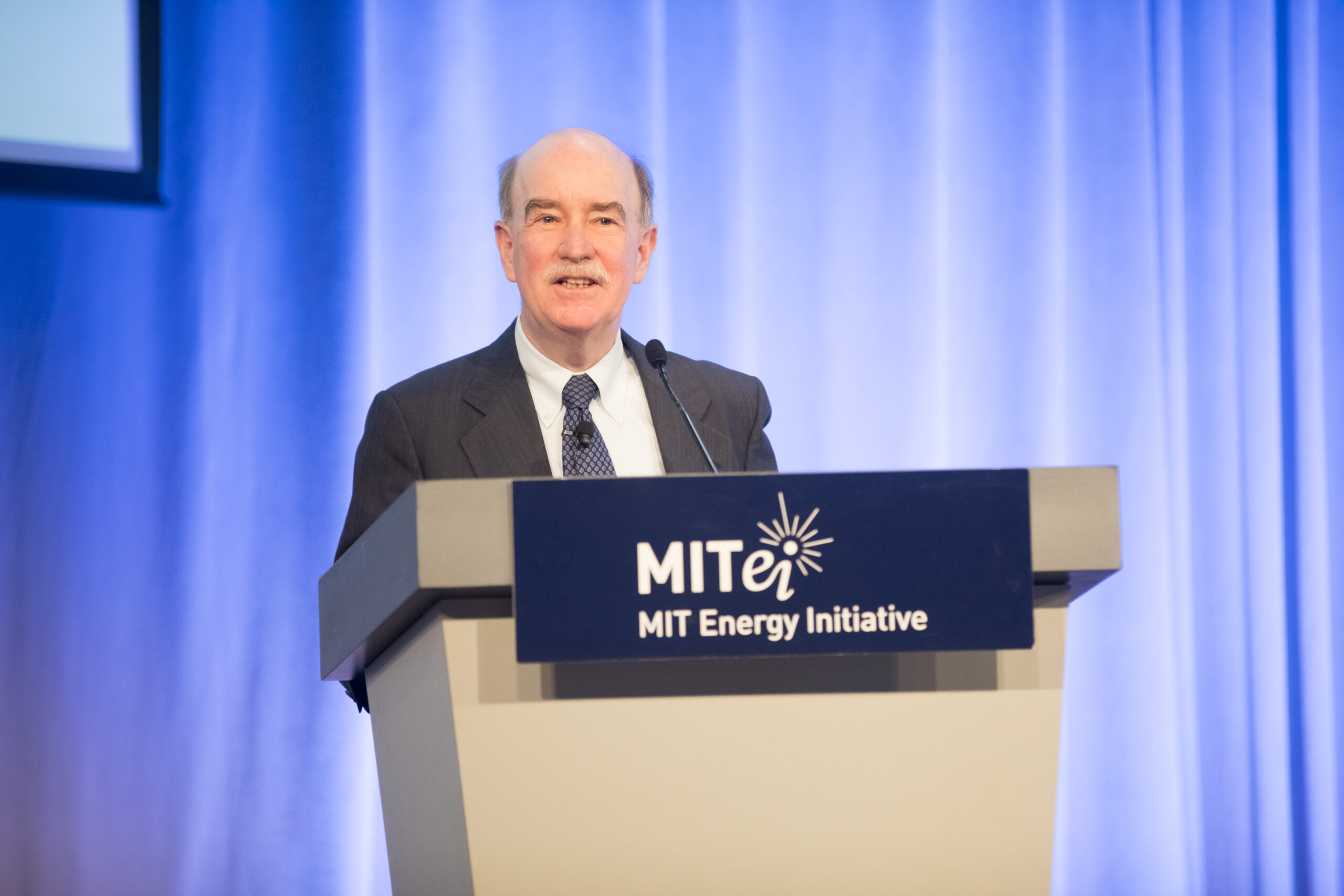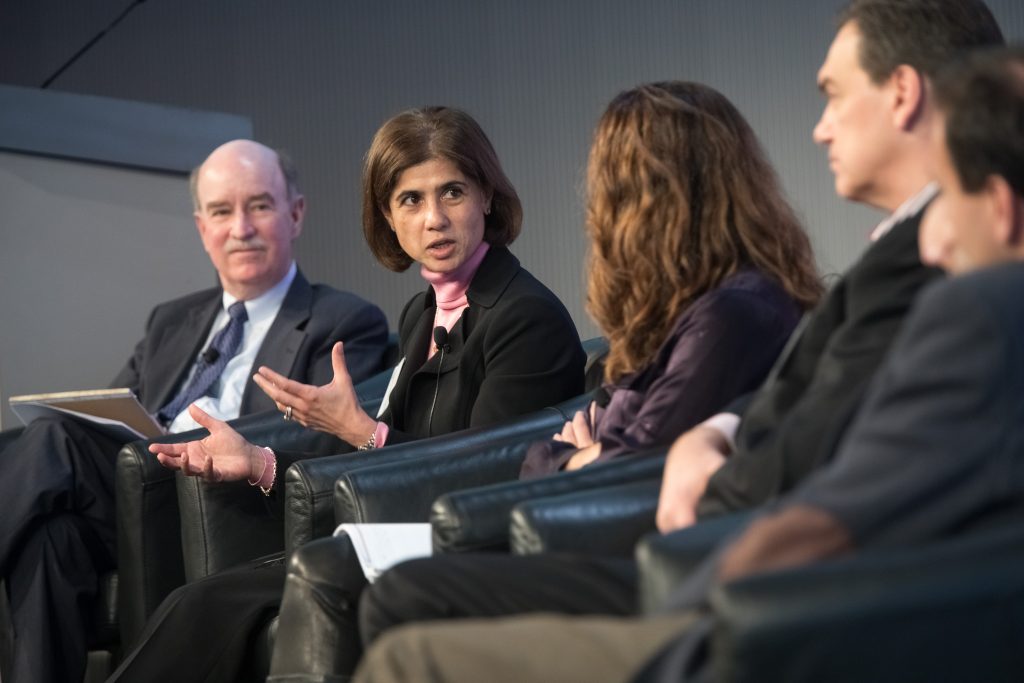
The fall 2017 gathering of the MIT Energy Initiative’s Annual Research Conference (ARC) had added meaning: 2017 marked ten years since the inaugural ARC. The conference, always filled with news from the forefront of energy research, was also a chance to reflect on the past decade of energy breakthroughs at MIT and to look forward to the advances being made toward a low-carbon future.
In his welcoming remarks, MITEI Director Robert Armstrong described the energy sector as “a field in flux.” He laid out the seismic changes taking place across our energy landscape, from increased distributed generation, to rapidly improving technology, to the importance of digitization for our electric power system. He also noted advances being made toward decarbonization. He said, “As of just recently, the power sector is no longer the largest emitter of CO2 in the US, showing the enormous potential for change when a sector commits to decreasing emissions. Now our focus must be on the urgent need for decarbonization in other sectors, such as transportation, which now holds the number one spot.”
Armstrong was joined by 13th U.S. Secretary of Energy Ernest Moniz, the founding director of the Energy Initiative. Moniz, who is a professor emeritus of physics and special advisor to the MIT President, reflected on the philosophy that led to MITEI’s launch by MIT President Emerita Susan Hockfield, saying “The core of the MITEI model is the conviction that, especially in the energy business, industry is key to solutions. The job of the MITEI director is to run a dating service, matching companies, faculty, and researchers based on common interests, to stimulate projects with real-world industry applications that can move the needle on energy technology.”
Fresh ideas from faculty members
Introducing a panel featuring MITEI-affiliated faculty whose work the initiative has supported, Robert Stoner, MITEI’s deputy director for science and technology and director of the Tata Center for Technology and Design, described how new faculty “often come to us with the freshest ideas and the most openness to the idea of projecting their knowledge onto a new field.”
Elsa Olivetti, the Atlantic Richfield Assistant Professor of Energy Studies in the Department of Materials Science and Engineering, recently published a study with her team on a technique for using natural language processing applications to pore through immense amounts of materials science literature to compile “recipes” for potential new materials. The aim of the research, which was supported in part by the MITEI Seed Fund Program, was to evaluate the value of text and data mining from peer-reviewed articles to accelerate the materials synthesis process.
“We try to link systems thinking to the development of new technologies and the design of new materials,” Olivetti said. She added, “As our systems become more complex, our supply chains more intricate, our ability to innovate by leveraging the work that’s been done to date will be critical.”
Jing Li ’11 deferred becoming a faculty member at the MIT Sloan School of Management to become a postdoctoral associate for a year. Her research this year is focusing on the economics of technology diffusion and adoption.
“Economics has a lot to offer when thinking about energy issues,” she said. “Determining, for example, when policy should step in and when policy should let the market do its own thing.” On her panel, she discussed, in particular, battery recharging infrastructure for electric cars. Auto manufacturers have designed different brands of electric cars with different style plugs and different communication protocol between the car and its charging equipment, making “achieving compatibility on the charging network,” as Li put it, difficult but not technologically infeasible.
In her presentation, Li discussed two key trade-offs in setting policies that seek to impose a uniform standard on fast-charging technology for electric vehicles: consumers would be better off with a single, better network of charging stations than the existing fragmented ones, but auto manufactures may invest less in such a common network. Li’s results conclude that a uniform fast-charging standard would increase the number of electric vehicles purchased and reduce costly duplicative investment.
In addition to research presented by faculty members, MIT undergraduate students had the chance to share their own research as poster presentations, offering them a chance to engage with industry members one-on-one about the real-world implications of their work.
Industry perspectives on the energy transition
At the conference, industry perspectives on the state of the energy sector provided a valuable balance to faculty research. Pratima Rangarajan, CEO of Climate Investments, the investment arm of the Oil and Gas Climate Initiative (OGCI), said that the 10 global oil and gas companies that founded and support OGCI and Climate Investments are well aware of the challenges posed when an ever-increasing need for energy on a global scale is set on a collision course with the dangers of a changing climate—which is why they started the initiative. “They are fierce competitors on a global scale, yet they are keen to come together to collaborate on these important issues,” she said. “That’s something we need more of as we tackle climate challenges.”

CEO of Climate Investments Pratima Rangarajan speaks on the need to collaborate as we tackle climate challenges. Photo: Bryce Vickmark.
Nick Pudar, the director and general manager of strategic initiatives at General Motors, described how his company is looking to the future, saying, “We are aggressively electrifying our portfolio.” He discussed early-stage opportunities for electric vehicle technology, from ride-sharing applications to autonomous vehicles. As did Li, Pudar noted the challenges inherent in a charging infrastructure that is still under development.
For all of these challenges, though, there are immense opportunities. “When we look at this overall space, we see an ecosystem that is ripe for innovation in every facet, and ripe for partnerships in every dimension,” Pudar said.
The three “D’s”
Many panelists discussed how this innovation landscape is being re-made by a suite of change agents: what speakers referred to as “the three D’s”: digitization, decarbonization, and decentralization. The trends this alliterative trio describes are as follows: an electric grid increasingly digitally connected; the movement toward renewables and other forms of low-carbon energy; and the evolution of the utility grid from a system based on central power plants to an ecosystem that also includes smaller-scale production capacity such as individual consumer’s energy-generating systems and microgrids.
On a panel about digitization in the energy sector, MIT Computer Science and Artificial Intelligence Laboratory (CSAIL) Professor Una-May O’Reilly remarked, “Computation is allowing us to observe all of our systems far more frequently than we used to and at a level of observation and a modality of observation that we’ve never done before.” All of this observational capacity leads to more data than companies have ever had access to in the past. “It’s where humans and data meet,” O’Reilly said. “Now, you’ve got a glut of data, but that data isn’t necessarily expressed in human terms.” The role of computation in industry is two-fold: to aid both observation and interpretation. O’Reilly painted the central importance of computation in this way: “Computation is the new electricity, and it will transform your businesses.”
This transformation comes with its own specific challenges and dangers, though. O’Reilly’s fellow panelists included experts on cybersecurity, machine learning, and blockchain, and discussed everything from payment methods like Bitcoin—designed for anonymity and privacy—to questions of security on an institutional level. Daniel J. Weitzner, founding director of the MIT Internet Policy Research Initiative and principal research scientist at CSAIL, laid out common misconceptions about cybersecurity. One of the most prevalent, Weitzner said, is the idea that better technology alone is the key to preventing cyber attacks. He noted that attacks that might be blamed on technological gaps are more often cases of “institutional failure,” where openings are made for attackers through human error—most notably, with employees failing to upload security updates.
“I’d argue that rather than just trying to figure out how you can lock down these Internet-of-Things devices more securely, we’re trying to look very carefully at what is the right regulatory environment, how do we understand user behavior to try to understand a better cyber hygiene, and how do we make sure that we get the right market forces operating toward better security as opposed to just lowering short-term costs.” Accordingly, part of Weitzner’s work at MIT involves consulting with policymakers about the best way to address cybersecurity concerns. “We’re in the process of working with this administration and with other governments around the world to try to encourage governments to think about cybersecurity in a more systematic way,” he said.
Digitization and cybersecurity aren’t the only areas in which today’s electricity sector are changing. In remarks on the evolution of the electric power system, MITEI Director of Research Francis O’Sullivan said, “Renewables are at energy’s big table right now, and that’s going to drive the capacity market forward. That’s changing how the grid itself works at that centralized level.” Christopher Knittel, the George P. Shultz Professor of Applied Economics at the MIT Sloan School of Management, elaborated on decentralization on a panel titled “The Evolving Power Market Landscape.” “Distribution companies and utilities are going to have to gain, or at least harness, new core capabilities,” he said. “Utilities and distribution companies are going to have to rethink what products they offer and how they bring the most value to their customers.”
“Gone are the days of a captive audience,” Knittel continued. “Now it’s very easy for me [as a consumer] to partially cut the cord, and I could cut the cord completely if I wanted to. But it’s actually the partial cutting of the cord that’s the problem, because if I put photovoltaics on my rooftop, I’m still using the grid, and effectively, the grid is my battery. And that’s creating all sorts of issues with pricing and the utility side of things.” Knittel went on to describe a host of areas in which utilities will need to evolve if they are to keep up with these changes in the energy sector, including pricing, data-driven products, and consumer-centric policies.
MITEI’s response to these questions and many more is the Low-Carbon Energy Center for Electric Power Systems Research, which is co-directed by Knittel and O’Sullivan. O’Sullivan introduced the center’s inaugural workshop, which took place immediately following the ARC’s closing panel and was open to all participants.
“With this open workshop, we will begin to discuss how we bring all of that capability together, so that we understand the important trade-offs on today’s and future systems, to see what’s going to be sensible from an economic point of view, from a technical performance point of view, and from a customer engagement point of view,” he said.
Regarding MIT’s role in working to solve these issues, O’Sullivan expressed confidence in the Institute’s faculty expertise and ability to address the challenges head-on, saying, “We’re excited to go after this topic through the center…. Without a doubt, electric power systems transitions will be a core element of the changing energy landscape in the coming years.”

Francis O’Sullivan, co-director of the Low-Carbon Energy Center for Electric Power Systems Research, discusses decentralizing the energy grid. Photo: Bryce Vickmark.
This article appears in the Spring 2018 issue of Energy Futures.